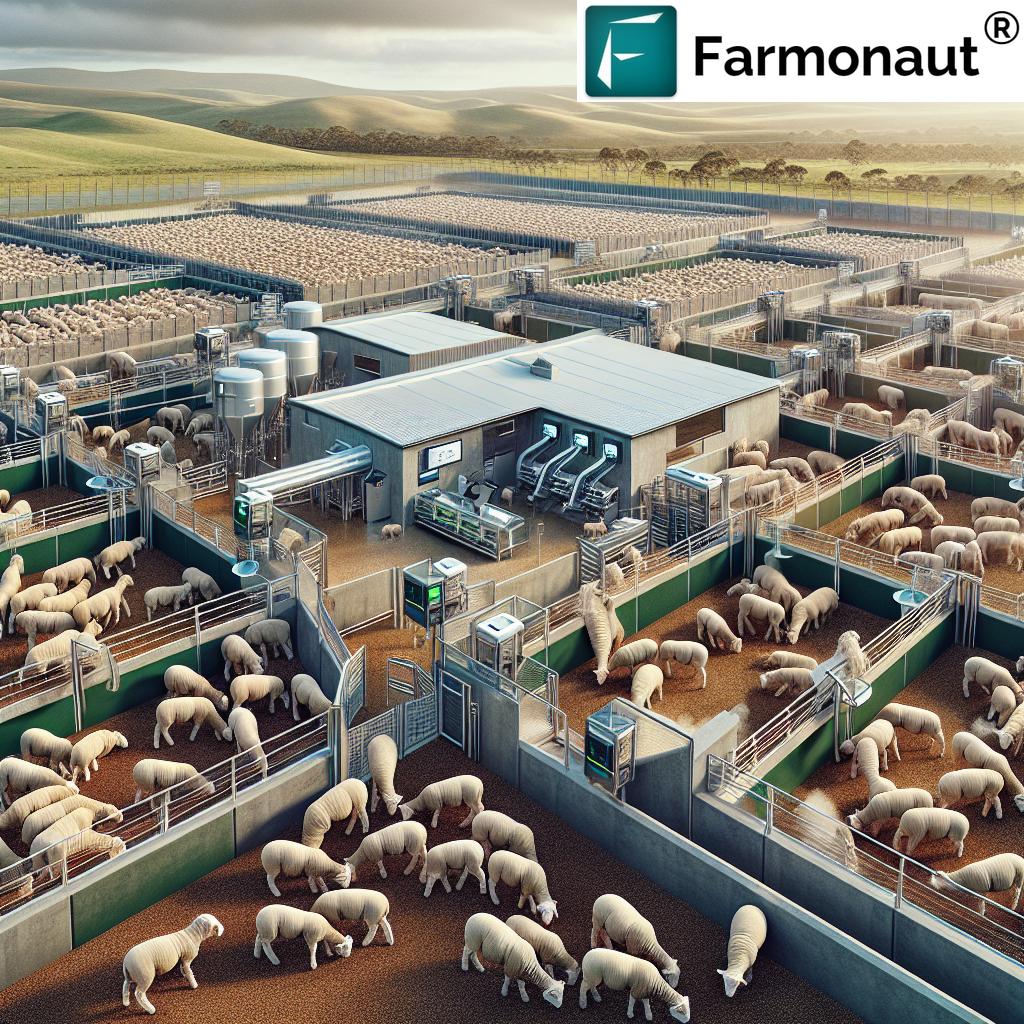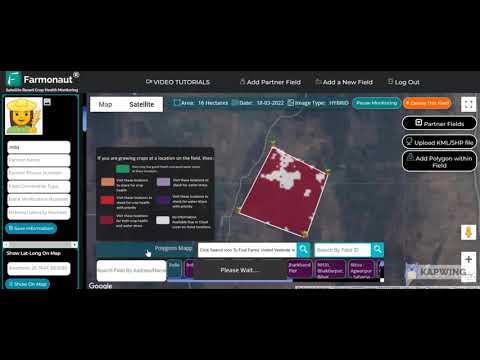Maximize Lamb Marking Rates: The Ultimate Guide to Managing Breeding Ewes in Containment for Wudinna Sheep Farmers
“Proper containment feeding can increase lamb marking rates by up to 15-20% in challenging weather conditions.”
Welcome to our comprehensive guide on managing breeding ewes in containment for Wudinna sheep farmers. As experts in precision agriculture and livestock management, we at Farmonaut understand the unique challenges faced by sheep producers in the Wudinna region. In this blog post, we’ll explore essential strategies to maximize lamb marking rates while ensuring the welfare of your breeding ewes in containment.
Sheep farming management has evolved significantly in recent years, with breeding ewe containment becoming an increasingly important practice, especially during harsh weather conditions or periods of resource scarcity. By implementing the right techniques and leveraging advanced technologies, you can optimize your flock’s productivity and ensure sustainable sheep farming practices.

Understanding the Importance of Breeding Ewe Containment
Breeding ewe containment is a crucial aspect of modern sheep farming management, particularly in regions like Wudinna where environmental conditions can be challenging. This practice involves keeping breeding ewes in a controlled environment during critical periods, such as pre-lambing and early lactation. The benefits of proper containment include:
- Improved control over nutrition and feed intake
- Enhanced monitoring of ewe health and lamb development
- Protection from adverse weather conditions
- Efficient use of resources, including water and feed
- Reduced stress on pastures, allowing for better recovery
By mastering the art of breeding ewe containment, Wudinna sheep farmers can significantly boost their lamb marking rates and overall farm productivity.
Optimizing Nutrition for Breeding Ewes in Containment
Proper nutrition is the cornerstone of successful breeding ewe management in containment. Ewes’ nutritional needs vary depending on their stage of pregnancy and lactation. Here’s how to ensure optimal nutrition:
- Energy requirements: Provide high-energy feeds, such as grain or pellets, to meet the increasing energy demands of pregnant and lactating ewes.
- Protein intake: Offer protein-rich feeds like lupins or high-quality hay to support fetal development and milk production.
- Mineral supplementation: Ensure adequate calcium, phosphorus, and trace minerals to prevent metabolic disorders and support lamb growth.
- Fiber content: Include sufficient roughage in the diet to maintain rumen function and prevent digestive issues.
Implementing a precision agriculture approach to nutrition can help optimize feed utilization and reduce waste. Farmonaut’s satellite-based monitoring system can assist in assessing pasture quality and planning feed requirements for your containment areas.
Maintaining Livestock Welfare in Confinement
Ensuring the welfare of your breeding ewes while in containment is crucial for both ethical and productivity reasons. Here are key aspects to consider:
- Space requirements: Provide adequate space per ewe (1.5-2 m² for dry ewes, 2-2.5 m² for lambing ewes) to prevent overcrowding and stress.
- Shelter: Offer protection from extreme weather conditions, including shade during hot periods and windbreaks for cold weather.
- Flooring: Use well-drained surfaces to keep ewes dry and prevent foot problems.
- Social needs: Keep ewes in appropriate group sizes to maintain natural social behaviors.
- Regular monitoring: Conduct daily health checks to identify and address any issues promptly.
By prioritizing animal welfare, you not only comply with ethical standards but also create an environment conducive to optimal lamb marking rates.
Implementing Effective Health Management Strategies
Proactive health management is essential for maintaining a productive breeding ewe flock in containment. Consider the following strategies:
- Vaccination program: Implement a comprehensive vaccination schedule to protect against common diseases such as clostridial diseases and OJD.
- Parasite control: Develop an integrated approach to manage internal and external parasites, including regular monitoring and strategic treatments.
- Foot health: Implement foot bathing and trimming programs to prevent lameness and foot rot.
- Stress reduction: Minimize handling stress through efficient facility design and gentle management practices.
- Biosecurity measures: Implement strict biosecurity protocols to prevent the introduction and spread of diseases within your flock.
Leveraging technology, such as Farmonaut’s AI-powered advisory system, can help you stay on top of your flock’s health management needs.

Sustainable Water Management for Contained Flocks
Efficient water management is crucial for the success of breeding ewe containment. Here’s how to ensure a sustainable water supply:
- Water quality: Regularly test and maintain water quality to prevent health issues and ensure optimal intake.
- Adequate supply: Provide sufficient water points to allow easy access for all ewes (1 water point per 40-50 ewes).
- Cleanliness: Clean water troughs regularly to prevent algae growth and contamination.
- Monitoring: Use technology to monitor water consumption patterns and detect potential issues early.
- Rainwater harvesting: Implement rainwater collection systems to supplement your water supply during dry periods.
Farmonaut’s satellite-based monitoring can help you assess water resources and plan for sustainable water management in your containment areas.
“Implementing precision agriculture techniques in sheep farming can reduce feed waste by 10-15% during confinement periods.”
Maximizing Lamb Marking Rates through Precision Management
To achieve optimal lamb marking rates, it’s essential to implement precision management techniques throughout the breeding and lambing process:
- Condition scoring: Regularly assess and record ewe body condition scores to ensure optimal nutrition.
- Pregnancy scanning: Utilize ultrasound scanning to identify twin-bearing ewes and manage them accordingly.
- Lambing supervision: Implement a strategic lambing supervision program to assist with difficult births and ensure early colostrum intake.
- Record keeping: Maintain detailed records of ewe performance, lamb birth weights, and growth rates to inform future breeding decisions.
- Genetic selection: Use data-driven approaches to select for traits that improve lamb survival and growth rates.
By leveraging precision agriculture techniques and data analytics, you can make informed decisions that lead to higher lamb marking rates and improved overall productivity.
Managing Pests and Predators in Containment Areas
Effective pest and predator management is crucial for protecting your breeding ewes and lambs in containment. Consider these strategies:
- Fencing: Install and maintain predator-proof fencing around containment areas to deter foxes and wild dogs.
- Rabbit control: Implement integrated rabbit control measures to prevent competition for feed and damage to infrastructure.
- Fly management: Use strategic baiting and trapping methods to reduce fly populations and prevent flystrike.
- Rodent control: Implement a rodent management program to protect feed supplies and prevent disease transmission.
- Guardian animals: Consider using guardian dogs or alpacas as an additional layer of protection against predators.
Regular monitoring and prompt action are key to successful pest and predator management in containment settings.
Leveraging Agritech Solutions for Sheep Producers
Embracing agritech solutions can significantly enhance your breeding ewe management in containment. Here’s how technology can help:
- Satellite monitoring: Use Farmonaut’s satellite-based crop health monitoring to assess pasture conditions and plan for containment periods.
- AI-powered advisories: Leverage AI systems like Farmonaut’s Jeevn AI to receive personalized management recommendations.
- Electronic identification (EID): Implement EID systems for accurate individual animal tracking and data collection.
- Automated feeding systems: Use smart feeders to ensure precise nutrition delivery and reduce labor costs.
- Remote monitoring: Implement camera systems and sensors to monitor containment areas from a distance.
By integrating these technologies into your farming practices, you can improve efficiency, reduce costs, and make data-driven decisions to optimize your flock’s performance.
Planning for Post-Containment Recovery and Grazing
Transitioning your flock from containment back to pasture requires careful planning and management:
- Pasture assessment: Use Farmonaut’s satellite monitoring to evaluate pasture recovery and determine optimal grazing strategies.
- Gradual transition: Implement a phased approach to reintroduce ewes and lambs to grazing, starting with short periods and gradually increasing.
- Supplementary feeding: Continue supplementary feeding as needed to support ewe and lamb nutrition during the transition period.
- Health monitoring: Closely observe the flock for any health issues that may arise during the transition back to pasture.
- Pasture management: Implement rotational grazing strategies to optimize pasture utilization and recovery.
Proper planning for the post-containment period is essential to maintain the gains achieved during containment and ensure continued productivity of your flock.
Breeding Ewe Containment Management Checklist
| Management Aspect | Best Practices | Expected Benefits |
|---|---|---|
| Nutrition |
– Provide high-energy and protein-rich feeds – Offer mineral supplements – Ensure adequate fiber intake |
10-15% increase in lamb birth weights |
| Health Management |
– Implement comprehensive vaccination program – Regular parasite control – Daily health monitoring |
20-30% reduction in ewe and lamb mortality |
| Water Management |
– Ensure clean, fresh water supply – 1 water point per 40-50 ewes – Regular water quality testing |
5-10% increase in feed intake and milk production |
| Parasite Control |
– Strategic drenching program – Regular fecal egg count monitoring – Maintain clean containment areas |
15-20% improvement in overall flock health |
| Space Requirements |
– 1.5-2 m² for dry ewes – 2-2.5 m² for lambing ewes – Provide adequate shelter |
10-15% reduction in stress-related issues |
Sustainable Sheep Farming Practices for Wudinna Producers
Implementing sustainable practices in your sheep farming operation is not only beneficial for the environment but can also improve long-term productivity and profitability:
- Soil health management: Implement rotational grazing and cover cropping to improve soil structure and fertility.
- Water conservation: Utilize efficient irrigation systems and water recycling techniques to minimize water usage.
- Biodiversity promotion: Maintain native vegetation corridors and implement integrated pest management to support local ecosystems.
- Energy efficiency: Invest in renewable energy sources like solar panels to power farm operations and reduce carbon footprint.
- Waste reduction: Implement composting systems for organic waste and explore innovative uses for sheep by-products.
By adopting these sustainable practices, Wudinna sheep farmers can ensure the long-term viability of their operations while contributing to environmental conservation.
Conclusion: Embracing Innovation for Optimal Sheep Farming Management
As we’ve explored throughout this guide, maximizing lamb marking rates through effective breeding ewe containment requires a holistic approach that combines traditional farming knowledge with modern precision agriculture techniques. By focusing on nutrition, health management, water conservation, and leveraging agritech solutions, Wudinna sheep farmers can significantly improve their flock’s productivity and welfare.
Remember, successful sheep farming management is an ongoing process of learning, adaptation, and innovation. Stay informed about the latest developments in agricultural technology and sustainable farming practices to ensure your operation remains competitive and resilient in the face of changing environmental and market conditions.
At Farmonaut, we’re committed to supporting sheep producers with cutting-edge satellite-based farm management solutions. Our platform offers real-time crop health monitoring, AI-powered advisories, and resource management tools to help you make informed decisions and optimize your farming practices.
To learn more about how Farmonaut can support your sheep farming operation, visit our web application or explore our API services for custom integration options.
Frequently Asked Questions (FAQ)
- What is breeding ewe containment, and why is it important?
Breeding ewe containment is the practice of keeping breeding ewes in a controlled environment during critical periods such as pre-lambing and early lactation. It’s important because it allows for better control over nutrition, health management, and protection from adverse weather conditions, ultimately leading to improved lamb marking rates. - How can I optimize nutrition for breeding ewes in containment?
Optimize nutrition by providing high-energy and protein-rich feeds, ensuring adequate mineral supplementation, and maintaining proper fiber intake. Use precision agriculture techniques to monitor feed quality and adjust rations as needed. - What are the key health management strategies for contained breeding ewes?
Key strategies include implementing a comprehensive vaccination program, regular parasite control, foot health management, stress reduction techniques, and strict biosecurity measures. - How can technology improve breeding ewe management in containment?
Technology like Farmonaut’s satellite-based monitoring can help assess pasture conditions, plan feed requirements, and optimize resource management. AI-powered advisories can provide personalized management recommendations, while EID systems enable accurate individual animal tracking and data collection. - What are the space requirements for breeding ewes in containment?
Dry ewes require 1.5-2 m² of space, while lambing ewes need 2-2.5 m². Adequate space helps reduce stress and improve overall welfare.






